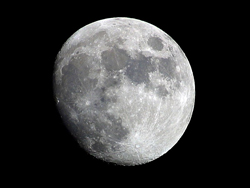The State Is a Harsh Mistressby David MastenMar. 05, 2012 |
Popular 
Report: Blinken Sitting On Staff Recommendations to Sanction Israeli Military Units Linked to Killings or Rapes

America Last: House Bill Provides $26B for Israel, $61B for Ukraine and Zero to Secure U.S. Border

'Woke' Google Fires 28 Employees Who Protested Gaza Genocide

Bari Weiss' Free Speech Martyr Uri Berliner Wants FBI and Police to Spy on Pro-Palestine Activists

John Hagee Cheers Israel-Iran Battle as 'Gog and Magog War,' Will Lobby Congress Not to Deescalate
  When I mention that I believe that it is not the proper role of government to subsidize research in space technology, the looks I receive from my fellow aerospace engineering classmates seem to suggest that they want to send me to the dark side of the moon (on the taxpayers' dime). When I mention that I believe that it is not the proper role of government to subsidize research in space technology, the looks I receive from my fellow aerospace engineering classmates seem to suggest that they want to send me to the dark side of the moon (on the taxpayers' dime).If there's one libertarian position that is exceedingly difficult to argue, it is the notion that scientific research should not be the concern of the state. This essay will focus on outlining two possible approaches that may allow my dear reader to explain free-market space technology to an outsider without sounding like a green-eyed Martian. These are as follows: 1. That privatized aerospace companies are more efficient in their allocation of resources when compared to nationalized space programsThe most popular prevailing argument against privatizing NASA comes in the intuitive objection, But without NASA, we would have never landed a man on the Moon! After observing the technical accomplishments of the Apollo 11 mission as well as its empowering symbolic meaning of having beaten the Soviets in the space race, to suggest that NASA ought to be abolished is to undermine its greatest achievements and all of the progress that has been made in aeronautics since its inception in 1958. For me, as an aspiring aerospace engineer, to suggest this to my peers is regarded as insanity. By unpacking the objection a little bit from its more rudimentary form, it eventually becomes clear that a more technical concern is being raised by the statist: How does the free market deal with high barriers to entry? The answer to this is frequently discussed by frustrated libertarians as if we were in a frenzied Mission Control room on hearing the infamous sound bite "Houston, we've had a problem." Just as James Lovell and the Apollo 13 crew had to bypass the moon, calculate a new trajectory to earth, and jury-rig the carbon-dioxide-removal system using whatever trinkets could be found on board, the libertarian must now maneuver a solution using only property rights, free and voluntary exchange of goods and services, and the nonaggression principle. To be sure, voluntary association and free cooperative actions can allow for such economies of scale to be mounted if there is a large enough incentive to do so. Moreover, the standard libertarian remark continues by showing that the addition of the state into such areas overrides the price mechanism, because the government is not bound by profit-and-loss constraints. This, in turn, gives way to inefficiencies due to crowding out, bureaucratic waste, special interests, centralized malinvestment, and so on. However, a more important point should be made on two fronts. First, a short-hand cost-benefit analysis reveals that the idea of privatizing the entire space industry is not at all unreasonable. Second, a philosophical explanation of the concept of "barrier to entry" provides the key to understanding scientific progress in a free society. The space shuttle, built by private organizations with government funding, was infamously advertised as having a payload costing solely $100 per pound. In actuality, it had a payload (e.g., satellites) of 24,400 kg with an estimated price tag of $1.5 billion per flight for 135 missions with 2 tragic crashes (14 killed) as well as 2 missions paid for by Germany.[1] Modern evidence shows that NASA and Mathematica were severely optimistic in their cost analysis,[2] arguably as a means of persuading President Nixon to authorize even more funding. The shuttle, in actuality, yielded a payload costing around $10,000 per pound a sizable hundredfold increase above the expected.[3] In the private space industry today, many scientific developments have allowed for a drastic reduction in cost-per-pound payload. Although not yet fully detached from the regulations set forth by the likes of the FAA, NASA, and the US Military, SpaceX (under PayPal cofounder Elon Musk) has managed to develop highly successful reusable spacecraft technology in the absence of state funding. SpaceX's launch agreement with NASA allows for 12 missions, costing a total of $1.6 billion in private funds and investments. While SpaceX's Dragon carries a payload of about 6000kg (1/4 that of the shuttle), the cost per flight is diminished by a factor of approximately 1/12 when compared to the shuttle.[4] However, accounting for costs across time and among varying missions is extremely difficult to do given the nature of technological progress. Furthermore, measuring the positive spillovers it generates (which spur additional growth) tends to be an impossible task. Thus, it is not entirely analogous to compare the average costs of NASA's federal shuttle program across the past 30 years with the costs of SpaceX in the private sector today. The libertarian layman cannot show definitively; rather we can only speculate and assert without proof the benefits of the unseen. Such cost comparisons are thus unlikely to convince the skeptical statist, and an alternative approach should be taken in a debate setting. General consensus suggests that the space shuttle was not highly efficient: the state continued throwing funny money at a fat rocket until it launched. The problem persists as the statists, stubbornly, are still not ready to admit that a company such as SpaceX could have mounted the high barrier to entry without government intervention. Their objection remains plausible considering the enormous amount of pioneering work that NASA has done with respect to scientific research and the benefits SpaceX has received from NASA for as it is said, if we see further it is because we stand on the shoulders of giants. The focus of the libertarian's drive to privatize the space industry is therefore not a campaign to show that companies like SpaceX could have scaled the high barrier to entry, but ironically to show that private companies would be smart enough not to place their resources on a project until the time was right, and the people were "ready" for it. After all, the cheapest costs of achieving a particular goal will result from a well-defined focus and specialized purpose. The kicker comes uon an analysis of what is meant by "high" barrier to entry. It is an entirely subjective concept, varying in accordance with the purchasing power present. To generalize, barriers of entry are often higher for a single individual than a private business, and more frequently higher for a single private business than the state which has the unique power to extract funds by way of violent force. Where the barrier to entry of a particular subjective end is too high, then the end cannot be pursued in the absence of additional outside means. Simply, barriers to entry are to be thought of as highly expensive means those that cannot be accessed by the presently available funds. It is important to note that only nonessential or luxury items seem to have these barriers to entry. The libertarian may concede that, in absence of NASA and the government-sponsored space race, it remains unlikely that a private company would have the financial incentive to put a man on the moon. This, like an expensive dinner or limousine, is a luxury that most private companies cannot afford. It was the government spending in NASA, prompted by the space race, that allowed the United States to mount the barrier to entry of the moon landing. This particular end placing a man on the moon is again too high for a private business to achieve without voluntary collective action. Moreover, such collective action would not have been likely in a truly free market, where Cold War propaganda and concerns about "national" defense served as an impetus that would have been absent otherwise. In the typical case of what is seen and what is not seen, private companies would have forgone the moon in favor of other missions with a better allocation of resources that is, productive missions within their means. In response to market supply and demand, the free market could have instead proceeded as it is finally beginning to do now, namely with the development of nanosatellite technology, reusable commercial spacecraft, and so forth. Presently, missions of low earth orbit (LEO) have a lower barrier to entry and costs are more readily manageable by private companies than gravitational earth orbit (GEO) or interplanetary travel. That is, the United States was not yet ready to go to the moon, and prematurely went after the rents when the value wasn't yet ripe and ultimately it did not secure those rents. There was a negative value in rushing the otherwise natural process of scientific development. Terry J. Anderson and Peter J. Hill's book The Not So Wild, Wild West explains this economic concept of rents and property rights on the frontier, and it is especially applicable when viewing space as the final frontier: Think about the frontier in the context of outer space. Mars is a planet we are exploring with unmanned probes, but it is not yet a place we are likely to inhabit in the near future. Any value that might be had from habitation would be offset by travel costs, risks, and distance from family and friends. Just as railroads increased the value of western land to non-Indians and shifted the frontier, we can imagine that improvements in space travel will increase the value of property on Mars. Eventually, the value of that property may become positive. When it does, that property will lie within rather than beyond the frontier. [5]Rents and profits are lost when stages of development are skipped in favor of loftier objectives beyond the frontier. NASA's mission selection left the United States using comparatively inefficient 1980s shuttle design technology well into the year 2011, while more modern designs, as are now emerging in the private sector, could have been used in the interim period. With that said, there is no intrinsic value in the space race apart from setting a national symbol of American exceptionalism and superiority. It would have been wiser for the United States to allow the Soviets to waste their money prematurely experimenting with Star Wars technology, such that the US economy could have strengthened with more valuable domestic investments here on earth. For it can be agreed that even in the blinding light of any imminent foreign attack, an enervated domestic economy remains the greatest threat to a country, causing more damage to a nation than any foreign gunfire, missiles, or bombs could ever hope to destroy. To demonstrate the ridiculousness of government-directed scientific programs, consider a parallel scenario in which private companies have already been present and progress has already been made for 50 years: automobiles. Now imagine if the state in addition to the auto bailouts authorized excessive spending to prop up a federal department to oversee the development of flying cars as a means of securing the United States against terrorist threat. One might imagine this proposal insane, just as Newt Gingrich has recently been ridiculed by the media for his insistence on developing moon colonies. There remains a reason why private automobile companies are not actively pursuing flying cars, and that is because they are currently well beyond the frontier the barrier to entry is far too high. Even if such a government program is ultimately successful, it would come at a great expense to far more important private developments. As Harry Browne rightfully points out, "If government had taken over the auto industry in 1920, today we'd all be driving Model-T cars and saying, 'If it weren't for the government, we'd have no cars at all.'" The skeptic soon finds that space technology ought to be treated like all other forms of technology, such as computers, cell phones, and the Internet. That is, with as little government intervention as possible. Truly, there is no definitive or otherwise distinctive feature about space technology that renders it necessary that government funds and operates it via NASA. However, the many challenges of space flight will be sorted out across time by the engineers and entrepreneurs just as the private railroad industry standardized rail-gauge sizes and time-zone adjustments without the oversight of the state. The high barrier to entry is to be mounted slowly but surely, as awe-inspiring innovation brings these achievements from beyond the horizon into the frontier. As Professor Langley was paid $70,000 (~$2 million today) by the state to fail to develop flight technology, the Wright Brothers were able to prevail on their own accord. As FAA regulations held back Sir Richard Branson (because he is a British subject) from launching Virgin Galactic with his own investments, scientific advancements in the field of aerospace were again delayed or hindered by the state. Just as evolution advances by way of adaptations and natural selection, price signals in a free market serve as a means to progress in technology through gradual changes over time. Government is not subject to these price signals, and inevitably makes poor allocations of taxpayer funds as a result. Entrepreneurs who actively seek profit find that there is no greater opportunity to do so than to invest their capital in scientific projects or endeavors. Contrary to popular opinion, scientific research and advancement in a free society would soar well beyond the present levels of today. If the ultimate concerns of the statists boil down to But without the state, I don't understand how aerospace will progress, and I like space a lot! then all attempts at convincing them are futile. For if they cannot be convinced that the free market has historically facilitated the development of private roads, railroads, canals, buses, cruise lines, airplanes, etc., there is zero possibility of their accepting the premise that government intervention in science is necessarily in virtue of its very internal structure inefficient and wasteful. These very same statists who, like me, care so much about scientific research and development would voluntarily fund these projects in the absence of a high tax burden. As it remains, the potential for progress is currently being blockaded by the force exerted by the state, and this force starves the most aspiring of minds from discovering the nature of our beautiful cosmos. __ David Masten is an aerospace engineering major at the University of Florida. See his blog: BlazingTruth.com. Send him mail. See David Masten's article archives. You can subscribe to future articles by David Masten via this RSS feed. Notes [1] Jeremy Hsu, "Total Cost of NASA's Space Shuttle Program: Nearly $200 Billion," Space and NASA News, Space.com. [2] Klauss Heiss and Oskar Morgenstern, "Mathematica Economic Analysis of the Space Shuttle System." National Technical Information Service. [3] Pat Duggins, "The Rise and Fall of the Space Shuttle, Book Review: Final Countdown: NASA and the End of the Space Shuttle Program," American Scientist, 2008, Vol. 96, No. 5, p. 32. [4] Elon Musk, "Why the US Can Beat China: The Facts About SpaceX Costs," SpaceRef. [5] Terry Lee Anderson Peter Jensen Hill, The Not So Wild, Wild West: Property Rights On the Frontier, Stanford, Calif.: Stanford Economics and Finance, 2004, p 11. |



